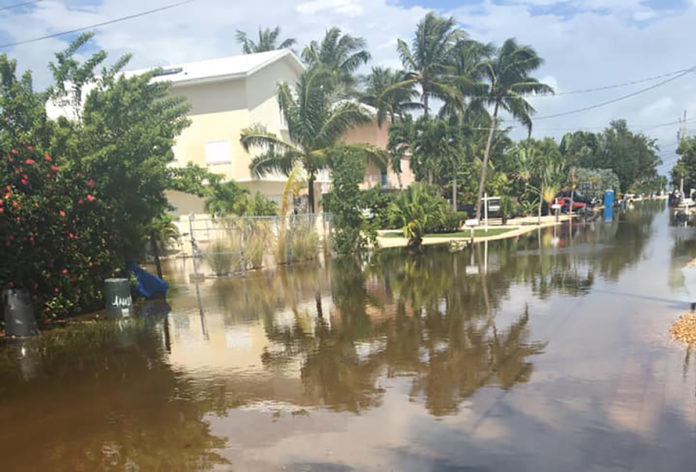
The Board of County Commissioners has voted to go after a pot of state grant money to pay for raising roads in Monroe County neighborhoods that face constant flooding, such as Key Largo’s Twin Lakes and Stillwright Point.
The county commissioners and staff are under pressure from residents who are frustrated about driving through saltwater to get into their homes.
Several public speakers from those neighborhoods stood up to vent about their situation. “It’s time to take action,” said Emilie Stewart of Stillwright Point, the MM 105 neighborhood in Key Largo. She said that in 2019, the streets around her home were under water for 94 consecutive days.
The Resilient Florida Grant Program, just approved by the state, authorizes the Florida Department of Environmental Protection to provide funds to local governments to protect communities from high tides and flooding issues. The state has set aside about $126 million annually for five years to be divvied up among Florida’s 67 counties, and the Monroe County commissioners have decided that they have a good shot at winning a part of that grant.
These matters were discussed at a special June 21st meeting that was specifically scheduled to hear presentations on sea level rise and how it affects Monroe County neighborhoods.
Experts from the National Oceanic and Atmospheric Administration (NOAA) showed data that suggests the seas will rise about a foot in the next century, or an inch every eight years.
To apply for the Resilient Florida Grant Program, counties have to use the NOAA data in order to show how vulnerable their neighborhoods are to rising water over the next few decades.
Judith Clarke, director of engineering for Monroe County, and engineering consultant Emilio Corrales, also showed a presentation with detailed maps using NOAA data with sea level rise plus king-tide level predictions for Monroe County neighborhoods for up to the year 2045. The data shows that 60 neighborhoods up and down the Keys, with 120 miles of road, will have flooding issues and become potential engineering projects. The breakdown of potential projects was as follows: 68.7 percent in the Lower Keys, 25.86 percent in the Upper Keys and 5.4 percent in the Middle Keys.
And, Clarke said, making just one street flood-resilient is expensive. Raising the roads and installing a pump station and injection wells in the Twin Lakes MM 103 neighborhood will cost $7.9 million.
This is where the Resilient Florida Grant Program comes in. The state will be accepting applications from July 1 through Sept. 1, and Monroe County will have to provide a 50 percent match of funds as well as vulnerability studies using NOAA data and other paperwork.
The $126 million in grant money is actually divided in different pots, and the FDEP decides which pot the project the counties are applying for goes in. For example, one pot has $100 million for infrastructure projects that are shovel-ready with engineering designs and paperwork already completed, while another smaller pot is designed for projects that are still in planning phases. Such a pot might be more appropriate for the Stillwright Point road-raising project, which still needs to be designed.
“I’m disappointed in that $100 million a year because I thought it was more than that,” said Commissioner David Rice. “We have 67 counties in Florida. What we could expect to pull down from $100 million is not expected to be a significant percentage.”
County Administrator Roman Gastesi replied, “To put it in perspective, just 10 years ago, just five years ago, the state wasn’t having these conversations (about grants) at all. As time goes on, maybe they’ll fund it more.”
Whitney Gray, administrator of the Florida Resilient Coastlines Program in the FDEP, added, “Within those 67 counties, there are also local governments at significantly varying degrees of readiness” to apply for these grants.
Mayor Michelle Coldiron agreed, and said the county has a great shot at getting approval for its grant applications because it already has done adaptation-areas and vulnerability studies and being shovel-ready with specific projects, like Twin Lakes.
“We are already ahead of the game,” she said.

























